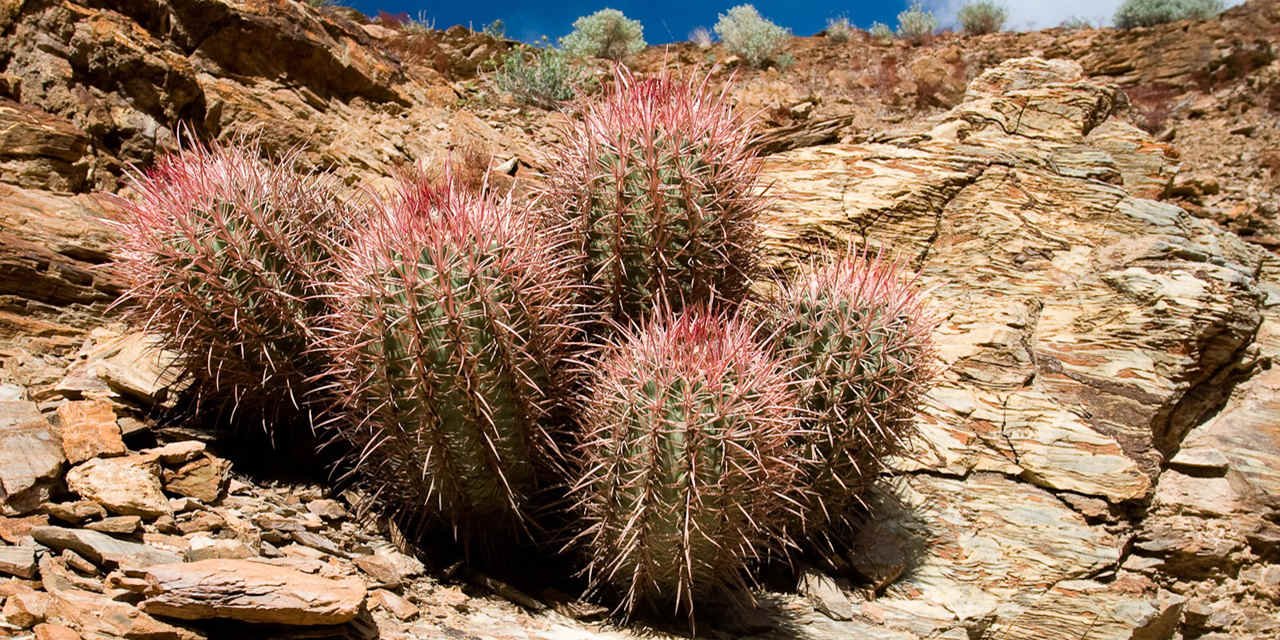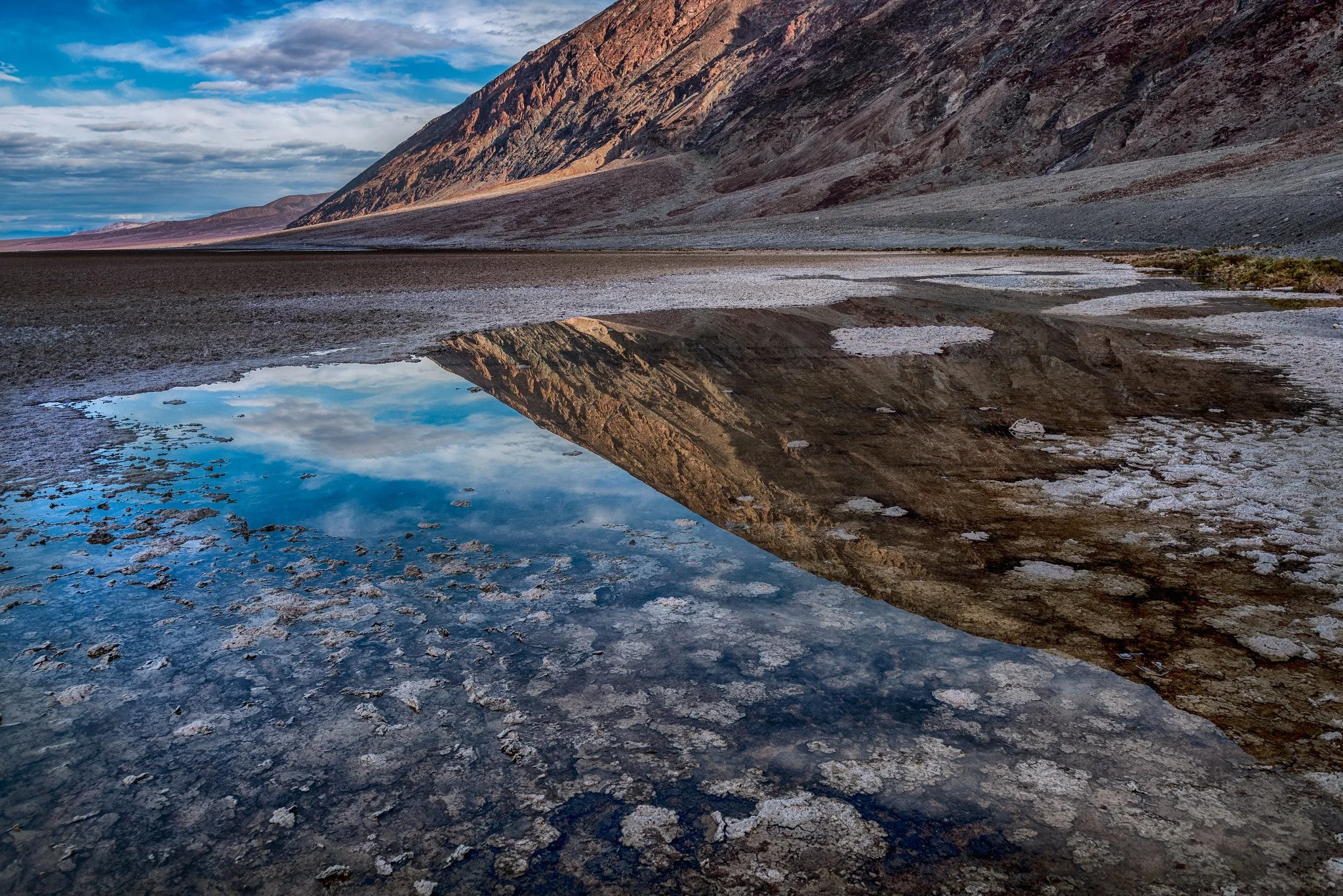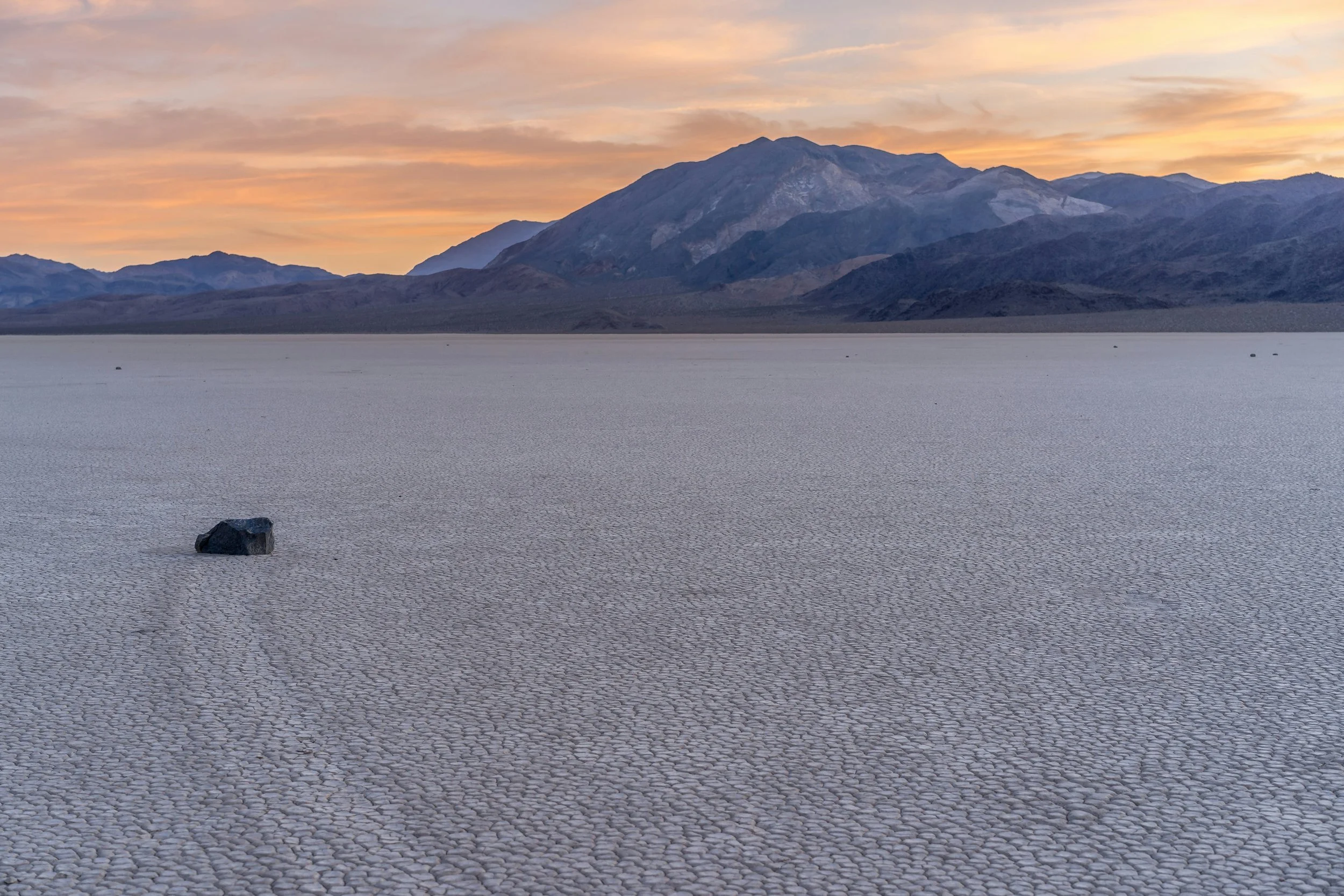Death Valley National Park: Don’t let the name fool you! Witness life persist at Badwater Basin (North America’s lowest point!), see rocks defy gravity at the Racetrack, and journey through time in Mosaic Canyon’s vibrant formations.
Straddling the edge of the Mojave Desert in southeastern California and bordering Nevada, Death Valley National Park spans a whopping 3.4 million acres of untamed wilderness, making it the largest park in the United States outside of Alaska’s.
And if you’re a fan of dry humor, you’ll appreciate that it’s the lowest and driest park in the country, getting less rainfall than your houseplant when you’re on vacation — just under 2 inches (51 millimeters) a year!
“Rocks drift across the flat desert landscape, leaving slug-like trails in the crust, without human or animal intervention.
Known as “sailing stones,” the rocks vary in size from a few ounces to hundreds of pounds. ”
Death Valley Comes Alive
The region got its nickname from a group of pioneers seeking a shortcut to the California coast. They became hopelessly lost in its unforgiving climate, and when they finally made it out, were quoted as saying, “Goodbye, Death Valley. “ The name has stuck ever since.
Despite its foreboding name and harsh conditions, the national park pulses with life. From snow-capped peaks to Sahara-like sand dunes, with vibrant wildflower meadows and winding canyons thrown in, the park offers a bounty of natural wonders. Keep your eyes peeled for roadrunners, often seen darting around Furnace Creek (though they’re not quite like the one famously featured in Looney Tunes cartoons).
Death Valley became a national park in 1994 and welcomes hundreds of thousands of visitors a year. Each corner of the park offers something different. There are numerous natural attractions, with ancient seas and lakes, volcanoes and warped mountains all sites that can be visited here.
With so many intriguing spots to choose from, which of its attractions should be at the top of your must-see list? Keep reading for my top 3 picks you won’t want to miss.
1: Badwater Basin
How low can you go? At 282 feet (86 meters) below sea level, Badwater Basin holds the title as the lowest point in North America. This incredible natural wonder is the remains of a lake that dried up tens of thousands of years ago.
The sprawling salt flats cover a jaw-dropping 200 square miles (500 square kilometers), shaped by seasonal flooding that deposits a glittering layer of sodium chloride (good ol’ table salt), calcite, gypsum and borax as the water evaporates.
The natural wonder got its name when a surveyor attempted to get his mule to drink from the small spring-fed pool near the boardwalk. The mule refused because of the water’s high salinity, and the surveyor marked the location on his map as “bad water.”
When Hurricane Hilary swept through the park in 2023, it flooded the flats, forming a temporary lake over the basin. (The park service reports that it has evaporated to only a few inches deep and is quite far from the road.)
But even in the harshest of environments, life finds a way. The lakes attract some extraordinary creatures like the Devils Hole pupfish and tiny Badwater snail — fascinating critters that have made this harsh landscape their home.
2: The Racetrack
Among Death Valley’s mind-bending phenomena are the mysterious moving rocks of Racetrack Playa. This dry lakebed is tucked away in a secluded valley between the Cottonwood and Last Chance Ranges and spans about three miles north to south and two miles east to west. However, getting to this remote site is no easy feat and requires a four-wheel-drive vehicle like a Jeep to handle the rugged terrain.
Here, rocks drift across the flat desert landscape, leaving slug-like trails in the crust, without human or animal intervention. Known as “sailing stones,” the rocks vary in size from a few ounces to hundreds of pounds. The phenomenon baffled geologists for years and has only recently been attributed to infrequent freeze-thaw conditions. It was previously thought to occur as a result of Earth’s magnetic field and, at one point, extraterrestrial mountain dwellers popping out during full moons.
Beyond the sailing stones, the Racetrack offers breathtaking views of the Panamint Range. Although the journey to reach this destination is long, the abundance of sights makes the trip to the Racetrack an unforgettable adventure.
3: Mosaic Canyon
There are many canyons in Death Valley, but Mosaic Canyon easily stands out as one of the park’s most popular day hikes. Along its trail, you’ll encounter the mosaic conglomerates that lend the canyon its name. These formations, known as breccia, consist of shattered fragments of marble and dolomite fused together over millennia and embedded in the canyon walls, resulting in a stunning mosaic-like pattern.
Beyond these unique geological finds and breathtaking canyon views, a trip here provides the perfect opportunity for a challenging hike across the rugged terrain. However, navigating the canyon can be tricky, with twists and turns hidden behind giant boulders and apparent dead ends. So, if you’re seeking a hiking experience that keeps you on your toes, Mosaic Canyon is ideal — just be sure to bring along a map.
You’ll find the Mosaic Canyon trailhead near Highway 190, not far from the Mesquite Sand Dunes. This hike winds through narrow passages, around boulder obstacles and past some dry waterfalls.
While the entire hike is less than four miles long, what makes it stand out is that you can tailor it to your liking, hiking as little or as much as you want.
Planning a Visit to Death Valley
Before visiting Death Valley, there are many important factors to consider. Research is essential, for, while some areas are suitable for all ages and abilities, others require experienced adventurers with proper gear. Check the National Park Service website for current conditions and updates. Areas of the park may be closed due to weather, road damage or construction.
When is the best time to visit Death Valley?
I highly suggest visiting from November to March, when temperatures are more bearable. Camping and ranger-led programs operate from late October to late April, so plan your trip during this period if you’d like to participate in these activities.
Avoid hiking during the scorching summer months from May to September, when temperatures average 100 degrees Fahrenheit (38 degrees Celsius). Most attractions are exposed, increasing the risk of dehydration and sunstroke.
What are the entrance fees for Death Valley? Do I need a pass?
The National Park Service charges an entrance fee and offers various passes, depending on your trip plans. Consider staying inside the park to spend less time driving in and out and to get the most out of your visit.
Is cell phone reception available in Death Valley?
Cell phone reception is limited in most areas of Death Valley. Download offline maps such as the National Park Service app or maps.me to help assure safe navigation.
What should I bring with me to Death Valley?
Create a checklist tailored to your visit and the season. Essentials include:
Maps
A portable charger
Sunscreen
Appropriate attire (hat, sunglasses, lightweight layers, breathable sturdy shoes or boots, and wool socks)
Water
Snacks
Death Valley: It’s not dead; it’s just waiting to be explored. Follow these tips, set your itinerary and be ready to be wowed. This park is full of surprises! –Isabella Hardy



























